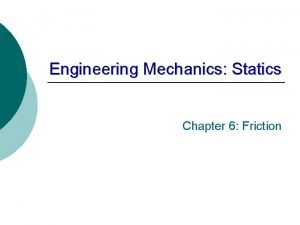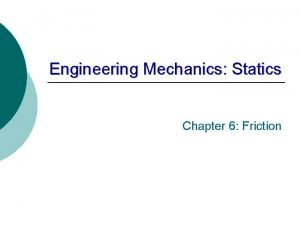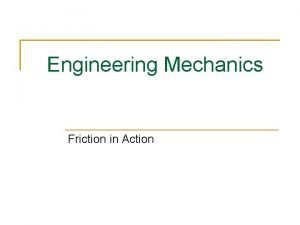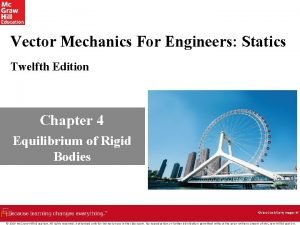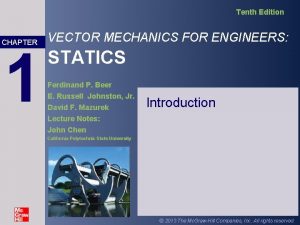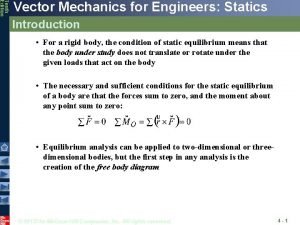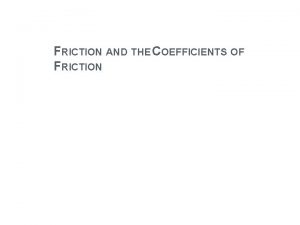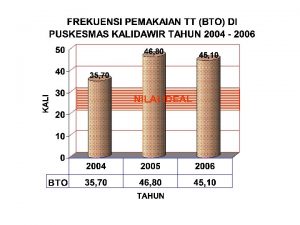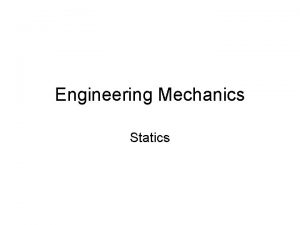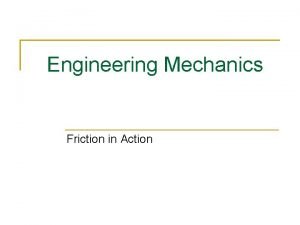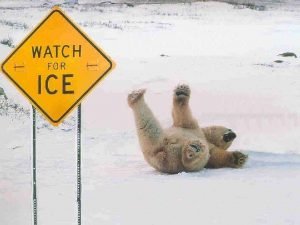Engineering Mechanics Statics Chapter 6 Friction Introduction Ideal










- Slides: 10

Engineering Mechanics: Statics Chapter 6: Friction

Introduction ¡ ¡ Ideal assumption – forces between contacting surfaces act normal to the surfaces Real surfaces – there are tangential forces between contacting surfaces = “Friction forces” ¡ Friction force occurs when one contacting surface tends to slide along another. l Minimize the effects: bearings, screws, gears, flow of fluids in pipe l Maximize the effects: brakes, clutches, belt drives, wedges

Types of Friction ¡ Dry friction - unlubricated surfaces in contact under a tendency to slide - friction occurs in the direction opposite to the impending motion - called Coulomb friction ¡ Fluid friction - adjacent layers in a fluid are moving at different velocity ¡ Internal friction –solid material under cyclical loading

Dry Friction ¡ Mechanism of Dry Friction ¡ Static friction: Fmax = ms. N limiting value for impending motion!!! ¡ Kinetic friction: Fk = mk. N

Dry Friction ¡ The direction of R is specified by tan a = F/N ¡ When the friction force reaches Fmax, the angle a reaches a maximum value fs. Thus, tan fs = ms ¡ ¡ When slippage is occurring, tan fk = mk The angles fs and fk are called angle of static friction and angle of kinetic friction which define the limiting direction of the total reaction R for each case.

Cone of Friction ¡ If motion is impending, R must be one element of the cone of static friction ¡ If motion is not impending, R is within the cone. The cone vertex angle is 2 fs ¡ If motion occurs, the angle of kinetic friction is applied. The reaction R must lie on the surface of cone of vertex angle 2 fk

Types of Friction problems 1. Motion is impending (body about to slip) Fmax = ms. N 2. Condition of motion is not known –find friction force F from equilibrium equation ¡ If F < Fmax (= ms. N) – body is in equilibrium and friction force = F ¡ If F = Fmax (= ms. N) – body is in equilibrium motion is impending ¡ If F > Fmax (= ms. N) – impossible not in equilibrium 3. Relative motion exist Fk = mk. N

Sample Problem 6/2 Determine the range of values which the mass m 0 may have so that the 100 -kg block will neither start moving up the plane nor slip down the plane The coefficient of static friction for the contact surfaces is 0. 30

Sample Problem 6/5 The three flat blocks are positioned on the 30 degree incline as shown, and a force P parallel to the incline is applied to the middle block. The upper block is prevented from moving by a wire which attaches it to the fixed support. The coefficient of static friction for each of the three pairs of mating surfaces is shown. Determine the maximum value which P may have before any slipping takes place.

Problem 6/9 The 30 -kg homogeneous cylinder of 400 -mm diameter rests against the vertical and inclined surfaces as shown. If the coefficient of static friction between the cylinder and the surfaces is 0. 30, calculate the applied clockwise couple M which would cause the cylinder to slip.
 Two dimensional force system
Two dimensional force system Engineering mechanics (9th) edition chapter 12 problem 30p
Engineering mechanics (9th) edition chapter 12 problem 30p Pearson education south asia pte ltd
Pearson education south asia pte ltd Friction in engineering mechanics
Friction in engineering mechanics Belt friction
Belt friction Jill is climbing. where does she need high friction
Jill is climbing. where does she need high friction Statics of rigid bodies
Statics of rigid bodies What is line of action
What is line of action Vector mechanics for engineers 10th edition
Vector mechanics for engineers 10th edition Mechanics
Mechanics Vector mechanics for engineers statics 10th edition
Vector mechanics for engineers statics 10th edition

